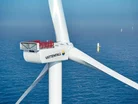Vattenfall Wind Farm Lays Foundations for Sustainability

Swedish energy company Vattenfall is using construction methods to reduce carbon emissions in its latest wind farm project, using an approach that could have positive implications for the wider construction sector.
Vattenfall is the Swedish multinational power company owned by the Swedish state, and as a leading European energy company, it is at the forefront of driving sustainability in the energy sector, both in the energy it delivers and the construction of the infrastructure that provides it.
For the 21-turbine onshore wind farm at Bruzaholm, Sweden, Vattenfall has procured concrete with a much lower carbon footprint than is usually for turbine foundations (211 kilograms per cubic metre – a 40% reduction compared to industry benchmarks). This is according to data from the Swedish Concrete Association, a national association of the main suppliers of concrete admixtures in Sweden.
The Bruzaholm wind farm will generate 460GWh of electricity annually when operational in autumn 2025.
Vattenfall’s procurement strategy reveals carbon savings
Head of Onshore Wind Procurement at Swedish energy company Vattenfall, Arthur Besse, says the project shows that there exist ways to reduce climate impact during construction.
"The extra price-premium is less than 2%,” he points out, “yet because we will need 7,500 cubic metres for the 21 foundations it will make a significant difference to the CO2 impact."
In terms of its own sustainability objectives, Vattenfall aims to achieve climate neutrality across its value chain by 2040. This includes reducing greenhouse gas emissions from purchased goods and services by 50% by 2030.
Construction tenders include sustainability measures
To help it on this journey, Vattenfall has developed a procurement model that allows contractors to submit carbon reduction proposals that are separate from base pricing. This approach addresses the challenge contractors face when sustainable measures increase costs.
The model enables assessment of both cost and environmental impact during tender evaluation. Construction firm Kanonaden Entreprenad secured the contract through this process.
Kanonaden Entreprenad proposed the use of low-carbon concrete alongside additional measures. These include biodiesel for site machinery, recycled plastic conduit pipes, recycled site signage, and optimised groundworks to minimise rock transportation.
First Mover Coalition sets industry targets
Showing its commitment to sustainability, in 2021 Vattenfall became a founding of the First Mover Coalition, an organisation that promotes industrial decarbonisation. The company has since committed to purchasing 10% breakthrough steel – a term used to describe steel that is produced with near-zero emissions – and 10% near-zero concrete by 2030.
Through its wind power division, Vattenfall has also joined the Steel Zero initiative by Climate Group, an international non-profit. This commitment includes using 50% low-emission steel by 2030.
Besse says: "This model for procuring goods and services has proved efficient for all parties and will now be used as a blueprint for coming projects.
Vattenfall’s sustainable procurement strategy is happening very much in the context of the wider sustainability ethos of the organisation, which itself is set by company CEO and President, Anna Borg.
Under her leadership, Vattenfall became a founding member of the First Movers Coalition, has set ambitious sustainability goals. The company's net-zero targets for 2040 have been approved by the Science Based Target Initiative (SBTi), making Vattenfall one of the first energy companies worldwide to achieve this recognition.
Anna explains: "This is an important confirmation that the targets we have set are in line with the ambitions of the Paris Agreement."
She points out that the green transition “is happening now” and that “it is required for us as a society to succeed". she says.
She also notes that the demand for fossil-free energy increased during 2023, with targets for the energy transition at European and country levels reaching unprecedented heights.
This means Vattenfall, and other companies like it, have a vital role to play. Anna's vision of the energy transition is one both of challenges and opportunities.
“The development of new energy infrastructure, from wind farms to nuclear power plants, will require significant construction expertise,” she says. “And the focus on sustainability in procurement and materials, such as fossil-free steel, will likely drive innovation in construction practices and materials.”
_____________________
Check out the latest issue of Construction Digital and sign up to our global conference series, Manufacturing LIVE 2024. Construction Digital is a BizClik brand.
- Cemex Names Most Innovative Construction StartupsTechnology & AI
- LEED: Building a Greener Future for ConstructionSustainability & Green Building
- Skanska and Holcim Lead Low-Carbon Road Building RevolutionSustainability & Green Building
- 2024 Structural Awards: Pioneering Sustainable EngineeringSustainability & Green Building




